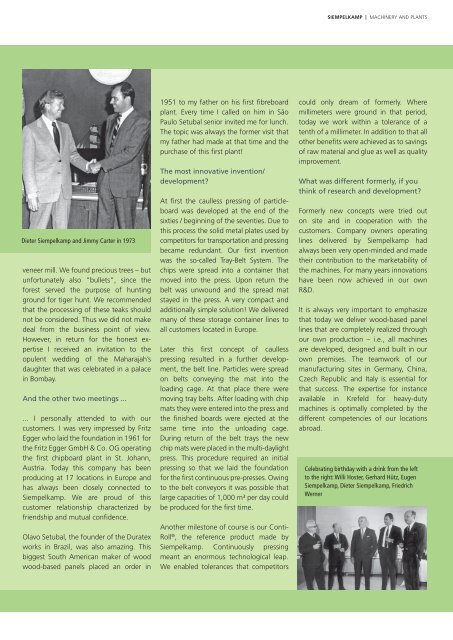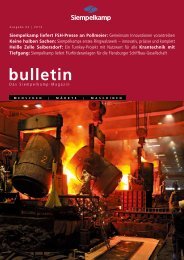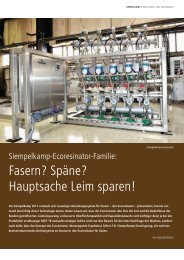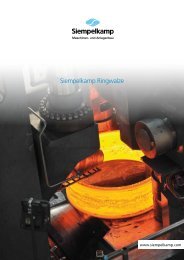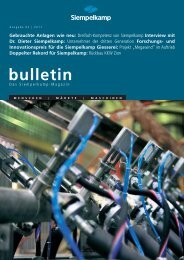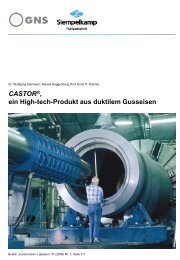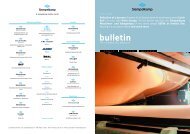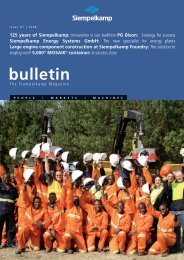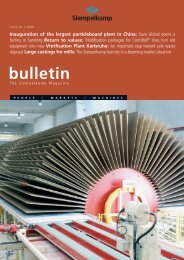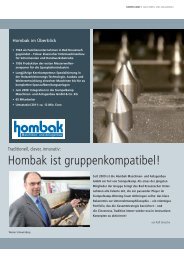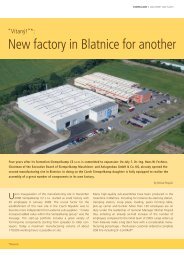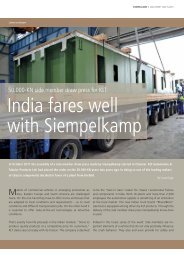bulletin - Siempelkamp
bulletin - Siempelkamp
bulletin - Siempelkamp
Create successful ePaper yourself
Turn your PDF publications into a flip-book with our unique Google optimized e-Paper software.
Dieter <strong>Siempelkamp</strong> and Jimmy Carter in 1973<br />
veneer mill. We found precious trees – but<br />
unfortunately also “bullets”, since the<br />
forest served the purpose of hunting<br />
ground for tiger hunt. We recommended<br />
that the processing of these teaks should<br />
not be considered. Thus we did not make<br />
deal from the business point of view.<br />
However, in return for the honest expertise<br />
I received an invitation to the<br />
opulent wedding of the Maharajah’s<br />
daughter that was celebrated in a palace<br />
in Bombay.<br />
And the other two meetings ...<br />
... I personally attended to with our<br />
customers. I was very impressed by Fritz<br />
Egger who laid the foundation in 1961 for<br />
the Fritz Egger GmbH & Co. OG operating<br />
the fi rst chipboard plant in St. Johann,<br />
Austria. Today this company has been<br />
producing at 17 locations in Europe and<br />
has always been closely connected to<br />
<strong>Siempelkamp</strong>. We are proud of this<br />
customer relationship characterized by<br />
friendship and mutual confi dence.<br />
Olavo Setubal, the founder of the Duratex<br />
works in Brazil, was also amazing. This<br />
biggest South American maker of wood<br />
wood-based panels placed an order in<br />
1951 to my father on his fi rst fi breboard<br />
plant. Every time I called on him in São<br />
Paulo Setubal senior invited me for lunch.<br />
The topic was always the former visit that<br />
my father had made at that time and the<br />
purchase of this fi rst plant!<br />
The most innovative invention/<br />
development?<br />
At fi rst the caulless pressing of particleboard<br />
was developed at the end of the<br />
sixties / beginning of the seventies. Due to<br />
this process the solid metal plates used by<br />
competitors for transportation and pressing<br />
became redundant. Our fi rst invention<br />
was the so-called Tray-Belt System. The<br />
chips were spread into a container that<br />
moved into the press. Upon return the<br />
belt was unwound and the spread mat<br />
stayed in the press. A very compact and<br />
additionally simple solution! We delivered<br />
many of these storage container lines to<br />
all customers located in Europe.<br />
Later this fi rst concept of caulless<br />
pressing resulted in a further development,<br />
the belt line. Particles were spread<br />
on belts conveying the mat into the<br />
loading cage. At that place there were<br />
moving tray belts. After loading with chip<br />
mats they were entered into the press and<br />
the fi nished boards were ejected at the<br />
same time into the unloading cage.<br />
During return of the belt trays the new<br />
chip mats were placed in the multi-daylight<br />
press. This procedure required an initial<br />
pressing so that we laid the foundation<br />
for the fi rst continuous pre-presses. Owing<br />
to the belt conveyors it was possible that<br />
large capacities of 1,000 m³ per day could<br />
be produced for the fi rst time.<br />
Another milestone of course is our Conti-<br />
Roll ® , the reference product made by<br />
<strong>Siempelkamp</strong>. Continuously pressing<br />
meant an enormous technological leap.<br />
We enabled tolerances that competitors<br />
SIEMPELKAMP | MACHINERY AND PLANTS<br />
could only dream of formerly. Where<br />
millimeters were ground in that period,<br />
today we work within a tolerance of a<br />
tenth of a millimeter. In addition to that all<br />
other benefi ts were achieved as to savings<br />
of raw material and glue as well as quality<br />
improvement.<br />
What was different formerly, if you<br />
think of research and development?<br />
Formerly new concepts were tried out<br />
on site and in cooperation with the<br />
customers. Company owners operating<br />
lines delivered by <strong>Siempelkamp</strong> had<br />
always been very open-minded and made<br />
their contribution to the marketability of<br />
the machines. For many years innovations<br />
have been now achieved in our own<br />
R&D.<br />
It is always very important to emphasize<br />
that today we deliver wood-based panel<br />
lines that are completely realized through<br />
our own production – i.e., all machines<br />
are developed, designed and built in our<br />
own premises. The teamwork of our<br />
manufacturing sites in Germany, China,<br />
Czech Republic and Italy is essential for<br />
that success. The expertise for instance<br />
available in Krefeld for heavy-duty<br />
machines is optimally completed by the<br />
different competencies of our locations<br />
abroad.<br />
Celebrating birthday with a drink from the left<br />
to the right: Willi Hoster, Gerhard Hütz, Eugen<br />
<strong>Siempelkamp</strong>, Dieter <strong>Siempelkamp</strong>, Friedrich<br />
Werner


